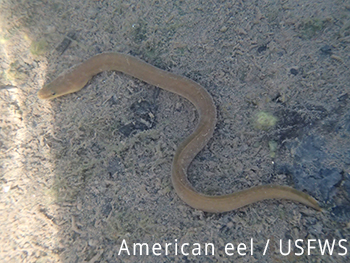 A revolutionary partnership between federal agencies is
capitalizing on an evolutionary partnership between freshwater mussels and American
eels to improve water quality. Through
the agencies’ work, both species are back in the Susquehanna River watershed.
A revolutionary partnership between federal agencies is
capitalizing on an evolutionary partnership between freshwater mussels and American
eels to improve water quality. Through
the agencies’ work, both species are back in the Susquehanna River watershed.
Most people think of eels as snakelike, slimy, and maybe
even scary. American eels, native to the Susquehanna River,
are indeed long, like snakes, and slimy to the touch. But luckily for swimmers, they are shy and
have teeth barely larger than sandpaper.
And luckily for everyone who depends on clean water, they are making a
comeback.
Eels are a migratory fish species that start and end life in
the Atlantic Ocean. Baby eels are
brought to our shores by the Gulf Stream current. They then swim up our freshwater streams,
where they stay up to 20 years before heading back downstream to the Atlantic
Ocean to spawn.
While in residence, eels serve as predators and prey, as
well as partners for freshwater mussels. Freshwater mussels live in streams and filter our water, but rely on the
presence of fish in the ecosystem to reproduce. Many
mussel species evolved to rely on specific fish species in a symbiotic
relationship.
The relationship is complex. Mussels lure in fish by displaying realistic copycats of mayflies,
crayfish, or minnows that are really flaps of tissue made by the mussel. The fish thinks this lure looks like food,
but when it takes a bite, the mussel shoots out a stream of tiny larvae that attach
to, or “infect,” the fish’s gills. Tiny
mussel larvae hitch a ride on the gills of fish until they mature into baby
mussels.
 If the right fish isn’t present in the stream to serve as a
temporary host for the larvae, the mussels cannot reproduce, and populations
die off. The most common freshwater
mussel in the Susquehanna River, eastern elliptio, needs the American eel.
If the right fish isn’t present in the stream to serve as a
temporary host for the larvae, the mussels cannot reproduce, and populations
die off. The most common freshwater
mussel in the Susquehanna River, eastern elliptio, needs the American eel.
Eels are amazing at getting where they want to go, sometimes
climbing up sheer walls. However, the 90-foot-high
Conowingo Dam, near the mouth of the Susquehanna River, is insurmountable. Dams in the Susquehanna River started blocking
eels from swimming upstream around 90 years ago. This curtailed a lucrative commercial eel
weir fishery. Most of us have never
eaten an eel, but for our ancestors who lived along the Susquehanna and Delaware
Rivers, eels were regular supper fare.
When eels stopped swimming up the Susquehanna River, the eastern
elliptio mussels in the river and its tributaries stopped making babies. Scientists estimate that most of the
remaining eastern elliptio mussels in the watershed are over 75 years old.
“The eel/mussel relationship and the sediment and nutrient
cycling ability of the mussel is a great example of the ecological services a
functioning stream can provide,” said Jason Fellon, Watershed Manager in DEP’s
North-central Region. “Mussels can very
effectively reduce the pass-through of nutrients to downstream reaches.”
To determine if reintroducing eels would help these mussels reproduce
and re-establish in the Susquehanna River watershed, beginning in 2010, the U.S.
Fish and Wildlife Service and the U.S. Geological Survey collected eels from
below the Conowingo Dam, transported them upstream, and stocked approximately
120,000 eels in Buffalo Creek, Union County, and 120,000 eels in Pine Creek,
Tioga County.
 “DEP staff performing field work in the West Branch
Susquehanna River and its tributaries have seen a dramatic increase in eel
populations in recent years, including two- to three-foot long adults,” said
Fellon. “These eels appear to be
dispersing and finding new habitat.”
“DEP staff performing field work in the West Branch
Susquehanna River and its tributaries have seen a dramatic increase in eel
populations in recent years, including two- to three-foot long adults,” said
Fellon. “These eels appear to be
dispersing and finding new habitat.”
As researchers hoped, the return of the eels has sparked a
return of the mussels. After five years,
the number of juvenile mussels found in Buffalo Creek doubled, and the number
of juveniles found in Pine Creek went from zero to 25% of the total eastern
elliptio mussel population.
Mussels born today will spend the next 80 or more years filtering
nutrients and sediment from our water. As
mussel populations increase, they will essentially increase the capacity of the
watershed to heal itself, helping Pennsylvania meet its federal obligations to
restoring the Chesapeake Bay.
“The increased presence of these mussels, through their
filtering ability, will allow more nutrients to be stored or converted to forms
that benefit other aquatic life, ultimately improving water quality,” said
Fellon.
Exelon Energy, owner of the Conowingo Dam, is now required
to truck eels around four large hydropower dams and release them in the
Susquehanna River. Each American eel’s arrival
upstream is a step toward restoring the ecosystem and improving water quality
for future generations.
Thanks to all of the contributors to this project!
- Maryland Department of Natural Resources
- Pennsylvania Fish and Boat Commission
- City of Sunbury
- U.S. Army Corps of Engineers
- Exelon Corporation
- Bucknell University
- Pennsylvania Game Commission
- Normandeau Associates
- Tiadaghton Audubon Society
- Merrill W. Linn Land and Waterways Conservancy
- Susquehanna River Basin Commission
- Pennsylvania House Redevelopment, LP
Julie Devers is a fish biologist with the U.S. Fish and
Wildlife Service, in Annapolis, MD.